Pierre Bulloz: Parisian Poetics in Silk and Satin—A Couturier for the Stage, the Salon, and the Sea
📌 Explore the world of Pierre Bulloz, a master of 1910s–1920s Paris fashion. From gold-threaded cloaks to serge travel suits, Bulloz blended artistry, elegance, and innovation. Perfect for historians, fashion students, genealogists, and those studying ocean travel culture.
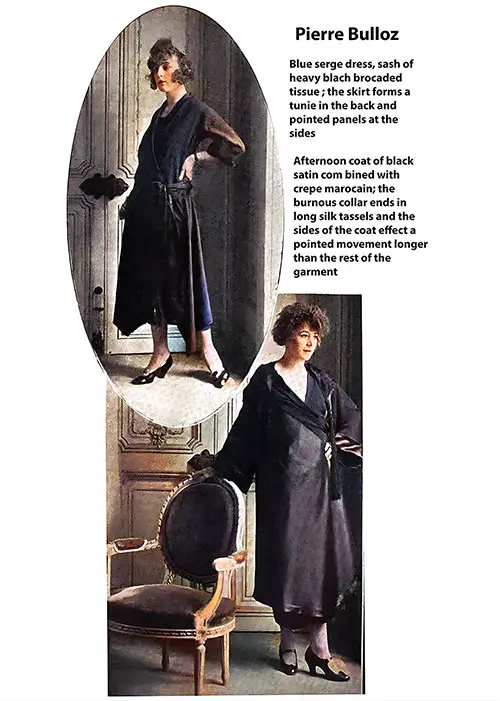
Pierre Bulloz Designs a Blue Serge Dress Adorned With a Heavy Black Brocaded Fabric Sash. the Skirt Features a Tunic Design at the Back and Pointed Panels on the Sides. Below the Dress Is an Afternoon Coat Crafted From Black Satin and Crêpe Marocain. the Burnous Collar Is Embellished With Long Silk Tassels, While the Sides of the Coat Create a Pointed Silhouette That Extends Longer Than the Rest of the Garment. (Garment Manufacturers' Index, June 1921) | GGA Image ID # 1a4806045c
👔✨ Pierre Bulloz: Sculpting Elegance in Motion—A Couturier for the Cosmopolitan Woman
Pierre Bulloz's legacy in early 20th-century Paris fashion is a remarkable synthesis of visual artistry, technical tailoring, and theatrical sensibility. His background as a painter gave his work an unmistakable attention to form, color, and human movement, while his understanding of couture made him a favorite among European royals, opera stars, and transatlantic travelers alike.
🧳 For the historically inclined: Bulloz offers a fascinating case study in Parisian modernism, gendered aesthetics, and global commerce—as relevant to the halls of Versailles as to the saloons of Cunard liners.
Pierre Bulloz, a distinguished Parisian fashion designer whose artistry, daring innovation, and theatrical flair defined a compelling intersection between fashion, femininity, and global travel culture. This page is designed for teachers, students, genealogists, and historians, featuring educational highlights, image commentary, terminology, and interpretive context.
Bulloz is too well known everywhere to need any praise as a couturier. Still, as an artist, he shows a life of tremendous activity coupled with inexhaustible creative power.
The artistic temperament, combined with keen business faculties, is too rare to be passed over lightly! In it lies the secret of Bulloz's success in every branch of his art.
He studied art as an artist, painting long before establishing himself in a business capacity. His love of line and color is manifest in all his creations, and years spent studying the human form give his models a rare sense of harmony and proportion.
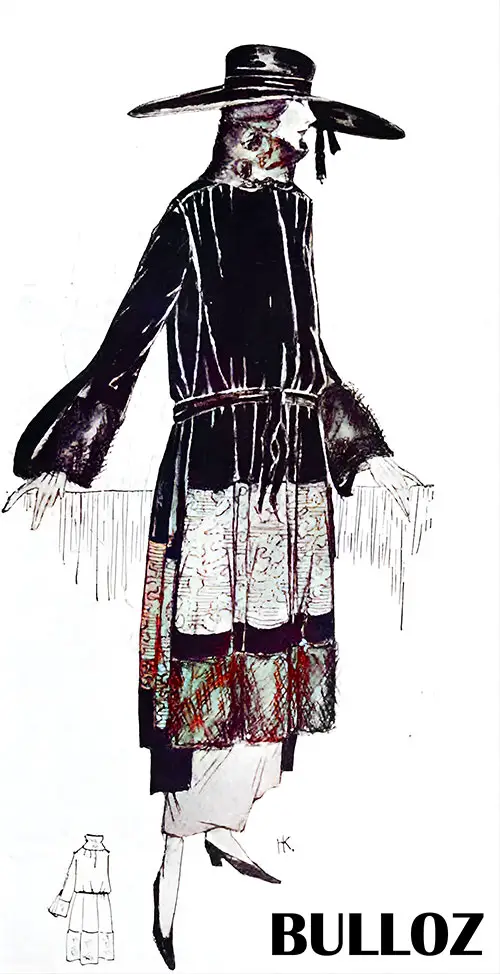
This Bulloz Black Satin Model Is a Stunning French Long Coat. It Features a Padded Effect, Fur-Trimmed Design, a Russian Blouse Back, and a High Collar That Is Satisfyingly Comfortable. (Good Housekeeping, September 1918) | GGA Image ID # 217b965ac1
One of Monsieur Bulloz's most essential secrets is making each model personal to the wearer. When a customer views the collection, Bulloz studies the lady, busily talking, and produces sketches, especially adapting the models to the client's figure, age, and requirements. That is his way of making and keeping the vast Parisian and cosmopolitan clientèle by right of taste and chic.
Bulloz's Italian heritage has bestowed upon him the patronage of some of the most influential women in Italy, including the esteemed Queen herself, a testament to the prestige and influence of his work.
An exciting side of the couturier's art is stage decoration and costumes, especially in Paris, where the keenest appreciation is bestowed on beautiful scenic effects. Bulloz's work in this area is particularly noteworthy. He has collaborated with the great Bakst, a renowned stage designer, helping in his most daring combinations. Their partnership has created some of the industry's most stunning and innovative costumes.
Many actresses, on the stage and in private life, come to him for their gowns—among them Mary Garden, that incredible artist.
Bulloz is one of the most advanced dressmakers in Paris. He is daring without vulgarity and novel without eccentricity.
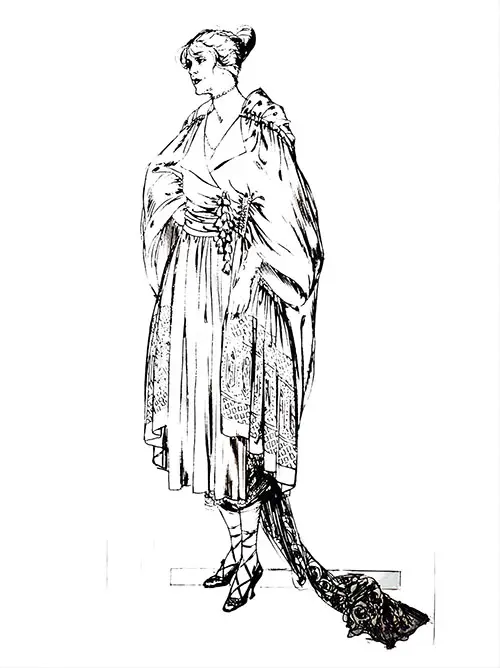
An Evening Cloak by Bulloz, Made of “Lancret” Blue Velours Mousseline, Is Gathered With a Cord at the Shoulders, Waist, and Hips. It Features Heavy Gold Guipure Trim and Is Worn Over a Black Chantilly Lace Frock. the French Train Is Long and Narrow, Elegantly Draping Over the Arm While Dancing. (The Delineator, February 1920) | GGA Image ID # 1a480e2dd4
The designer's unique approach is evident in the effects he has introduced this season. His preference for floating panels and detached wing-like effects while maintaining a straight outline showcases his love for Greek and sculptural draperies, a testament to his innovative design sensibilities.
The designer's skillful use of contrasting fabrics in the same tone is a delight. A standout example is a delicate mauve gown of crêpe and satin, adorned with steel embroidery, perfectly complemented by a loose summer coat in the same tone, collared and cuffed in chinchilla. The steel embroidery forming a yoke ties the ensemble together, showcasing the designer's meticulous attention to detail.

It’s "Manteaux" Like These From Bulloz and Premet That Have Captured the Heart of Paris. (Women's Home Companion, September 1919) | GGA Image ID # 217b98a364
From a business point of view, Bulloz's career has been singularly busy and has been a constant success. After four years as a director at Beer's, he courageously decided to leave this firm and establish his own house on the Champs-Elysées. This move, filled with risks, ultimately paid off, inspiring many in the industry.
As the first prominent dressmaker to depart from the esteemed Place Vendome, Bulloz's move to the Champs-Elysées was a monumental shift, sparking a wave of intrigue and admiration that reverberated throughout the fashion industry.
Following a string of financially successful partnerships that, in his words, 'overwhelmed the artist's individuality,' Bulloz made a resolute choice. He reclaimed the reins of his business, reaffirming his commitment to his unique artistic vision.
His new premises on the sunny Boulevard Malesherbes will soon extend to the entire house after his 'opening' in August, a highly anticipated event that will introduce him once more to the world of buyers and mark a new chapter in his career.
Mayer et Bulloz - Parisian Fashion House
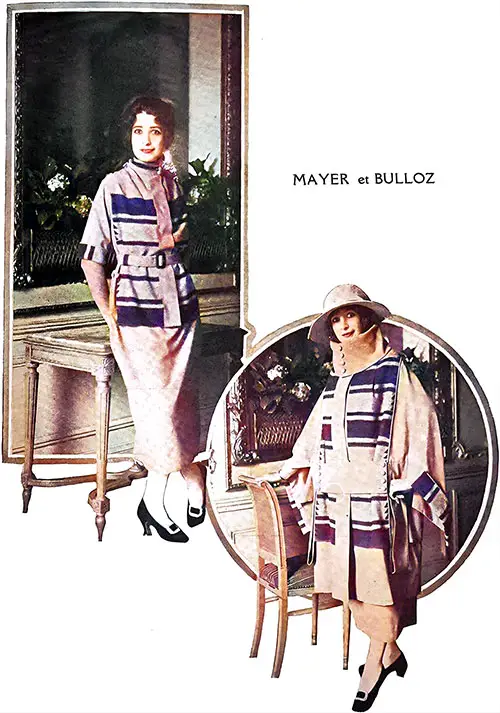
Dress and Cape Coat of Beige and Black Striped Burnous by Mayer et Bulloz. Broad Band of Different Material Accentuates Waist Line of Jacket. Novel Combinations of Materials in introduced in New Models. (Garment Manufacturers' Index, October 1920) | GGA Image ID # 1a3d291a25
The well-known tailor Maurice Mayer, partnered a year ago with an equally old Parisian, Bulloz, who manages the firm. This connection has produced the happiest results.
The collection of tailleurs at Mayer et Bulloz is a testament to luxury and quality. The efforts of their reputed designer, Madame Burling, have resulted in a winter collection that is rich in materials. The use of excellent rough kinds of stuff, sacking or blanket, velours de laine, serges, and velvets in rich, warm tones of browns and blues, adds a touch of opulence to their collection.
One of the most successful gowns this season, brought over from Paris, is the 'Vive la France,' a Bulloz creation that harks back to the Pompadour period. This gown, along with several other costumes designed by M. Bulloz for the Queen of Spain and the ladies of the Court, showcases his exceptional talent. The models shown on this page were personally selected by M. Bulloz for Harper's Bazar, adding to their exclusivity.
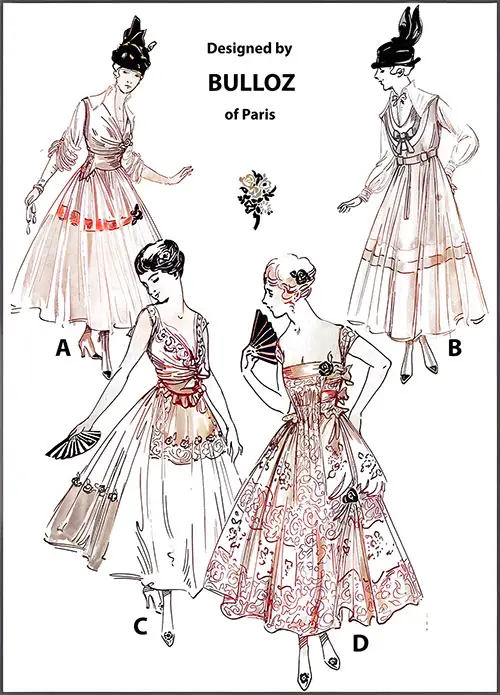
Four Dresses Designed by Bulloz of Paris Include a Spring Frock of Grey Voile and Taffeta, a Pink Taffeta Dinner Dress, a Voile and Blue Taffeta Dress, and a Coral-Colored Faille Evening Gown. (Harper's Bazar, February 1916) | GGA Image ID # 1cd6969e72
(A) "Ginette" is a spring frock of grey voile and taffeta. Bright blue velvet covers the hoop in the petticoat and shows through the voile skirt. The bodice is of tulle and taffeta.
(B) This pink taffeta dinner dress is appropriately named "Du Barry." The apron of silver lace is ornamented with flowers in Pompadour colorings, and blue velvet is used as trimming.
(C) Voile and blue taffeta are the materials used in this charming model, "Le Miracle." The guimpe is of white tulle, and the large tulle collar is held with a bow of cherry-colored velvet.
(D) Coral-colored faille brocaded in silver, with panels of silver. Lace over mousseline de soie in Nattier blue, makes this evening gown which Bulloz calls "Rosalind." The roses are deep coral.
Although every type I would write the length of a winter jacket is exhibited, the long, straight kind predominates. When worn open, the exceptionally high collar ending in a ruff or snugly encasing the chin is frequently lined in the shade, contrasting with the waistcoat blouse accompanying it. There is also a fair sprinkling of shawl collars, always becoming, fastening at the waist.
The skirts are not quite plain here; a series of small tucks at the waist tapers toward the hips, while a flat panel may be stitched down the back and front, leaving a band three inches wide standing out at the sides.
A charming little costume of nasturtium bure has a skirt like this: the coat is short and straight, with a seal shawl collar.
When jackets are long and straight, a new idea to accentuate the low waistline is to insert a broad band of a different material at the hips, which may also end in streamers, thus providing a refreshing change from buttons as a fastening.
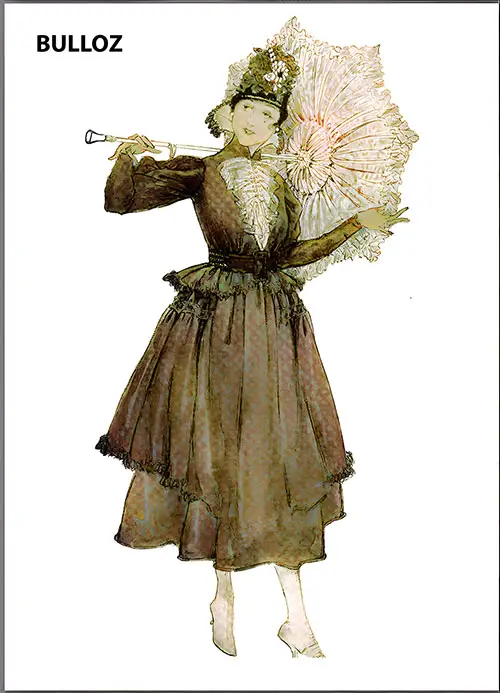
This Bulloz Design, Made of Brown Taffeta With a Waist Accented by a Blue Pin Seal, Features Significant Changes to the Sleeves. It Features a New Inverted Parasol Trimmed With a Shirred Mull. (Harper's Bazar, March 1916) | GGA Image ID # 1cd5e9859b
A long, hunter's green velvet suit has a wide black satin belt of this persuasion, a shawl collar of gray lamb, which fur edges the flaring cuffs.
A blue serge model of three-quarter length shows a different line. The swagger of the full basques is intensified by a hem of broad rushing. The idea is repeated at the neck, where the collar forms a Pierrot frill.
Robes-manteaux are incredibly numerous; faint lines of satin ciré or waxed braid are used to trim them. The latter may be worn open, allowing for a little-embroidered vest to appear. Beltless or not, a slight shirring at the sides does not take away from their severe straightness, nor do the high collars.
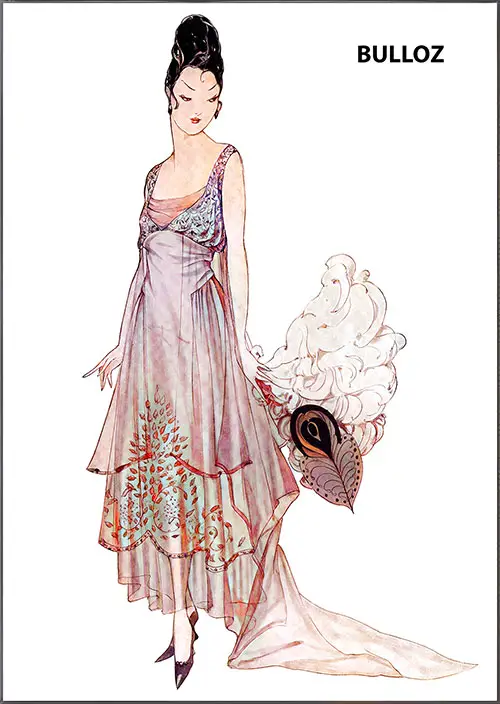
An Exquisite Evening Gown of Grey Satin by Bulloz Is Embroidered in Pearls and Silver and Then Veiled With Grey Chiffon. Particularly Interesting Is the Back With Its Becoming Panel Drapery of Satin. (Harper's Bazar, November 1916) | GGA Image ID # 1cd60f75ec
An elephant-gray duvetyn has such a collar. The skirt is box pleated, and a wide satin ciré sash threaded through the pleats at the hips ties in a bow. A stylish blue serge striped in a tiny waxed braid has a high turned-over red serge collar. It fastens down the side under large triangles of beautiful red and gold embroidery.
An innovation combines blue serge and black lace; pleating of the serge cuts a voluminous lace tunic, and a standing ruff at the neck carries the note of lace onto the bodice.
The more elaborate gowns offer the greatest variety in material, cut, and color: beads and jet, gaily colored brocades, charmeuse (one beautiful cream is draped and combined with brown lace), much chiffon (a brown silk voile has a dashing nasturtium sash trimmed with brown roses), Georgette, velvets in good lighting colors, turquoise, and periwinkle.
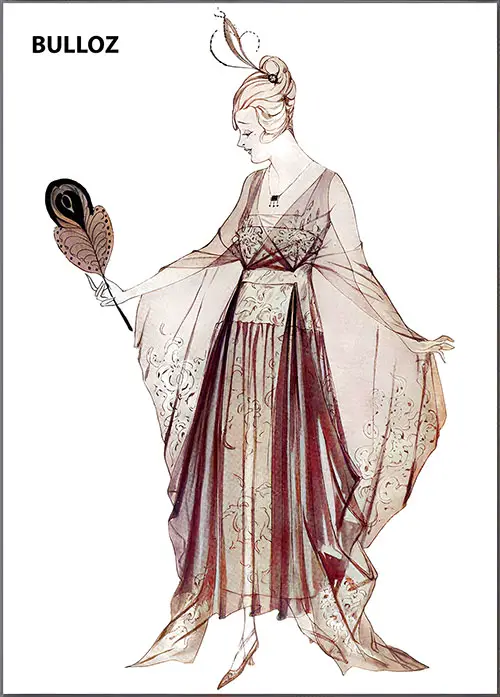
The Designer Bulloz Intricately Embroidered the Black Tulle Draperies With Gold and Silver on a Luxurious Dinner Dress Made of Gold Brocade. (Harper's Bazar, November 1916) | GGA Image ID # 1cd62449dd
Mousseline de soie waxed makes a delightful but, to me, unknown fabric. Electric blue is effective, as is dark gray over brick satin.
Scalloped by three rows of skunk, an expansive coral pink ciréd muslin coat is worn over finely pleated pink lace and crêpe. Turquoise velvet and black lace cunningly draped, a pointed train of each resulting, is chic.
White satin, the skirt a succession of black lace points, has strings of pearls looped up all around the waist.
What is known as the enveloping movement is carried out here in a slightly different manner. The square décolleté with a pointed back and square train is preferred. Skirts are tightly draped. The skirt is draped toward the back and partly concealed under a square train.
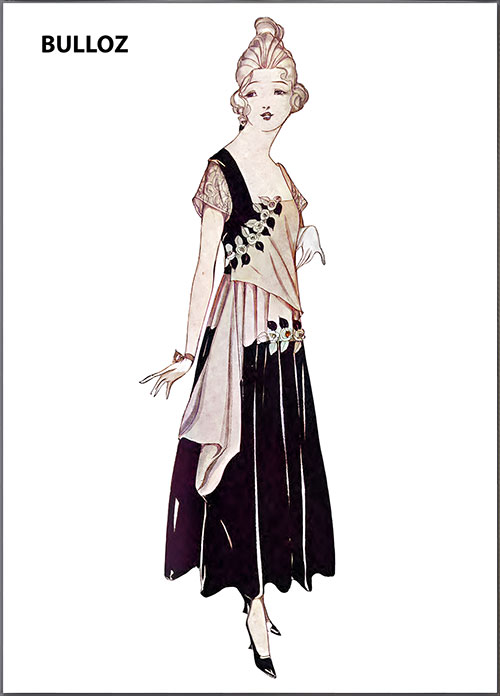
Bulloz Is a Couturier Known for Evening Frocks Featuring Hand-Made Roses. the Pink Flowers, Combined With Black Velvet and Silver Leaves, Create a Striking Accent on a Black and Pearl Grey Satin Dress. (Harper's Bazar, December 1916) | GGA Image ID # 1cd62d6dec
A glorious model of jet and beads gives the unbroken Egyptian line, the waist indicated by a scarab. A blue and yellow brocade, square-necked, has squares of the brocade hanging in points from each side, lined in bright blue, the whole effect being one of vivid but not glaring color.
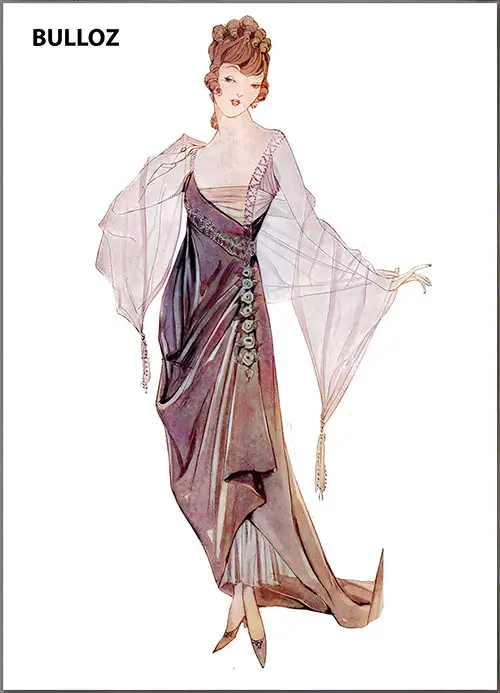
The Draperies of a Rose Satin Gown by Bulloz Are Decorated With a Garland of Roses and Silver Leaves. the Bodice, Made From Rose Chiffon and Pale Rose Tulle, Is Embellished With Pink Diamonds. Harper's Bazar, November 1916, p. 69. GGA Image ID # 1cd63236da
Bibliography
"Mayer et Bulloz" in the Garment Manufacturers' Index, New York: The Allen-Nugent Co. Publishers, Vol. II, No. 3, October 1920: 28.
"Bulloz: A Parisian Designer of Note," in Garment Manufacturers' Index, New York: The Allen-Nugent Company, Vol. II, No. 11, June 1921: 32.
🛳️ Relevance to Ocean Travel & Global Fashion Culture
As elite and upper-middle-class women took to the seas in increasing numbers from 1900–1925, they required wardrobes that balanced:
🔹 Shipboard chic (lightweight coats, tailored jackets, satin day dresses)
🔹 Grand soirée style (luxurious cloaks, gold embroidery, dramatic trains)
🔹 Practical refinement for promenade decks and portside strolls.
🌍 Bulloz’s use of lightweight fabrics like crêpe marocain, voile, and mousseline de soie, along with adaptable tunics and robes-manteaux, made his designs ideal for travel. Whether dressing European royalty or American socialites, his fashions were suited to cruise liners, royal visits, and global diplomacy.
🌟 Most Engaging Content Highlights
🎨 Artistry Meets Couture
Bulloz trained first as a fine artist, and this is evident in his use of:
🔹 Contrasting textures: satin and chiffon, brocade and lace.
🔹 Architectural silhouettes: pointed panels, sculpted collars, asymmetrical trains.
🔹 Painterly composition: embroidered roses, steel threadwork, and jewel-toned fabrics.
His frequent collaboration with Ballets Russes designer Bakst infused his gowns with theatricality—ideal for evening galas at sea or social functions abroad. 🎭
🖼️ Noteworthy Images
🟦 Blue Serge Dress & Afternoon Coat | (Image ID #1a4806045c)
A study in structure and elegance. The burnous collar, tunic back, and tassel detailing create a Moroccan-meets-Paris silhouette—perfect for cultural explorations abroad.
🖤 Black Satin Long Coat with Russian Blouse Back | (Image ID #217b965ac1)
This coat’s fur trim and high collar represent jet-set practicality—a garment suited to both cold-weather ports and fashionable urban arrival.
🪄 “Lancret” Evening Cloak with Gold Guipure | (Image ID #1a480e2dd4)
A romantic, dance-friendly design with a narrow French train—easy to imagine worn during shipboard balls or European soirées.
🌹 Gown of Rose Satin Draped with Roses and Silver Leaves | (Image ID #1cd63236da)
Ideal for teaching symbolism and color theory in fashion: this look is floral, romantic, and distinctly modern in its softness.
👗 Pink Taffeta Dinner Dress, “Du Barry” | (Image ID #1cd6969e72)
Historic inspiration meets modern elegance. The Pompadour flourishes and silver lace apron are reminiscent of court fashion reimagined for the 20th-century social elite.
🧵📘 Brief Dictionary of Fashion Terms for the Curious Reader
Burnous Collar: A large, draped hooded collar inspired by North African cloaks.
Ciré: Fabric with a shiny, waxed finish.
Crêpe Marocain: A richly textured silk fabric with a grainy surface.
Faille: A ribbed silk or cotton fabric with a slightly stiff feel.
Guimpe: A high-necked under-blouse worn beneath a low-cut bodice.
Guipure Lace: Heavy lace without netting, often with bold motifs.
Manteaux: French for coats; used here for statement outerwear.
Panel Drapery: A flat section of fabric falling gracefully from the bodice or waist, often used in back trains.
Robe-Manteaux: A combined dress-and-coat ensemble, often worn open.
Velours Mousseline: A lightweight, sheer velvet with drape.
🎓 Encouragement for Students & Educators
💡 Students writing about:
- Fashion and Art Deco influence
- Couture and celebrity culture
- Women’s changing roles through fashion
- Ocean travel and the global style economy
...will find in Bulloz a perfect case study. His designs reflect the freedom, luxury, and modernism of the early 20th century. With links to theatre, royalty, and world travel, he stands at the crossroads of culture and commerce.
📚 Use the GG Archives to build well-cited essays with original source material—including rare magazine spreads, fashion sketches, and high-society imagery. No blog comments here—but endless material for research papers, classroom projects, or multimedia storytelling.
